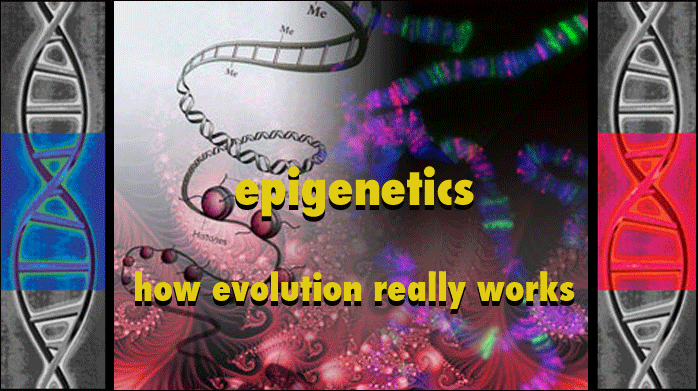
© 2011 By Gary Vey (http://www.viewzone2.com/morphogenetic.html)
Part 1
Inherited Programming: How does it work?
A farmer I know often goes out to shoot possums that invade his garden in the middle of the night. His dog chases them up a tree and, with a flashlight reflecting in their eyes, they are easy to spot and dispatch. But not always. Increasingly, more possums are apparently learning not to look at the light and they remain invisible -- and continue to live. He joked that this was an example of natural selection, with nature favoring the successful strategy for survival.On the surface this seems to make sense. But does it really?
Offspring inherit lots of characteristics from their parents' DNA. There are genes for size, hair color and brain development -- but was there somewhere in the possum's genes that stored the strategy of not looking at the hunter's flashlight?
This is not a new question. Survival behaviors of animals have been studied by many researchers, but their inherent programming has never been fully explained. How exactly is this strategy coded and passed on from one generation to the next? Can DNA do this?
The most famous study of survival strategies is outlined in Richard Dawkin's book, The Selfish Gene. Let's take look.
A maze of possibilities
 There is some evidence that strategic behavior can be transmitted by genes. A classic example is Tryon's experiment on the maze-running ability in rats [1][2]. Tryon managed to breed two groups of rats by selectively mating the "best" maze runners with each other and, conversely, the "worst" maze runners. After seven generations he could show that he had produced two distinct heredity groups with a vast innate differences in their maze running abilities. This was believed by many to be proof that behavior was inherited, and therefore a product of DNA. But his results were soon challenged.
There is some evidence that strategic behavior can be transmitted by genes. A classic example is Tryon's experiment on the maze-running ability in rats [1][2]. Tryon managed to breed two groups of rats by selectively mating the "best" maze runners with each other and, conversely, the "worst" maze runners. After seven generations he could show that he had produced two distinct heredity groups with a vast innate differences in their maze running abilities. This was believed by many to be proof that behavior was inherited, and therefore a product of DNA. But his results were soon challenged.
When the "worst" maze runners were subjected to an enriched environment with more objects to explore and more social interactions to enjoy, their maze running abilities were restored. What's more interesting is that their offspring continued to have improved maze running abilities -- even without the stimulating activities [3]. In just one generation this "inherited" deficit was earased. This result suggested that the maze running ability was the product of an interaction of genes and environment, where the genetic effect is only seen under some environmental conditions. If that is true, how can genes change so quickly -- even in the sameorganism?
Small changes have big results
Scientists continued to examine how small genetic changes could alter complex behavior. Their first success was in explaining how an animal could be programmed to be more "hawkish" or "dovish". As reported in Principles of Neural Science (1992):
Some amazing examples of genetically encoded, complex behaviors have been studied in monozygotic twins -- siblings with the exact copies of their DNA -- who were separated at birth and reared in different environments.
Epigenetics: the new frontier
If the genes can be likened to long list of instructions, we have learned that some of these instructions can be marked "to do" (activated) or "ignore" (inhibited). Scientists have recently come to understand that, although the list itself remains intact, the various instructions undergo activation and inhibition in a process called epigenetics.
This process is vital when a single fertilized egg (zygote) divides and the cells differentiate to become muscle, tissue, nerve cells skeletal cells, etc. Each different type of cell requires a different set of proteins and different sets of instructions are activated or inhibited. These sets of instructions stabilize and continue over the life of the cell and over many generations as the cell divides and reproduces.
Scientists were surprised to discovered that epigenetics was an on-going process, not limited to differentiating cell types. In fact, they found that environmental factors, such as toxins, temperature or the availability or scarcity of food, could cause epigenetic changes that modified the behavior and form of the organism. These adaptations happened quickly and within the lifespan of the same organism. In some cases, the changes to "activate" or "inhibit" certain instructions were passed to subsequent generations implying that our Darwinian concept of multi-generation evolution needs amending. Evolutionary adaptation can occur in a single generation!
Back to the twins...
 It was always assumed that our DNA was an unchanging set of instructions. And because of this, MZ twins were assumed to have been born with identical sets of genes. But scientists were curious about some cases where one twin would develop certain types of diseases and the other did not. When they examined the DNA of older twins they were shocked -- their DNA was different! [5]
It was always assumed that our DNA was an unchanging set of instructions. And because of this, MZ twins were assumed to have been born with identical sets of genes. But scientists were curious about some cases where one twin would develop certain types of diseases and the other did not. When they examined the DNA of older twins they were shocked -- their DNA was different! [5]
A study published in The American Journal of Human Genetics, conducted by scientists at the University of Alabama at Birmingham and universities in Sweden and the Netherlands examined the genes of 10 pairs of MZ identical twins, including 9 pairs in which one twin showed signs of dementia or Parkinson's disease and the other did not. According to Professor Jan Dumanski:
So it appears that nature has equipped the organism with a two tiered approach to adaptation. First, temporary changes in gene expression can be implemented through epigentics. These will take effect quickly and can be passed to subsequent generations to help the organism adapt, but they are NOT permanent. However, if these changes persist and prove successful in the adaptation of the organism, permanent genetic mutations will follow and constitute a form of natural selection.
Who designs these adaptive changes?
We ask the question with "who" because we recognize that the specific genes involved in the adaptation of the organism appear to be selected intelligently. Intelligence usually signifies sentience and consciousness. But perhaps we err in our inquiry.
The intelligence of natural selection is not in each specific choice of adaptation. Rather it is in the grand design of the natural selection process which appears to involve something as yet illusive to mechanistic science.
How does the possum adapt to the hunter's flashlight? Initially it may be a random case of over-sensitivity to the light resulting from some anomaly in protein synthesis. Because this anomaly proves to be a successful strategy for survival, its epigenetic code endures until it has reached a certain saturation in the population of possums. At this point, presumably, some mechanism is able to make the gene expression permanent.
But there is also the possibility that the sensitivity to light was not a random anomaly.
In the next installment of this series, we will examine a theory which explains how the organism's cells "know" when a particular epigenetic change has been an effective survival strategy. We will explore the so-called mitogenetic and morphogenetic fields, how an organism communicates with the field and how epigenetic changes can spread throughout a species -- even when there is no physical contact or reproductive lineage.
We'll be treading on hollowed ground as we explore the possibility that fields of energy permeate the universe, unifying and coordinating everything.
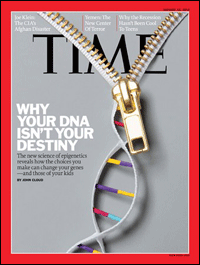 The feature article began with the story of an European farming village that endured several years of crop failure and famine. But there were also a couple of extremely plentiful years, during which the inhabitants over-ate and became gluttonous. During the glutton years, some of the children were entering puberty and subsequently got married and had families.
The feature article began with the story of an European farming village that endured several years of crop failure and famine. But there were also a couple of extremely plentiful years, during which the inhabitants over-ate and became gluttonous. During the glutton years, some of the children were entering puberty and subsequently got married and had families.
When researchers first looked at this population, they were expecting to find birth defects and inherited deficits from the near starvation conditions that persisted for years. Instead, they discovered that the offspring of the pubescent gluttons had an amazing decrease in lifespan of more than 32 years!
The Time Magazine article used this research to illustrate how epigenetics, caused by environmental factors, can have hereditary consequences that ripple through many generations. But there were two important questions that were not addressed: first, why would epigenetics punish the offspring for their ancestor's over-eating by shortening their lifespan? Second, how is it that the offspring of both males and females were effected?
In mammals, the male produces sperm as needed during puberty and so the DNA is subject to environmental effects and presumably epigenetic adaptations. Research has shown, for example, that boys who smoked cigarettes at age 11 had male offspring that were more unhealthy and obese than children of non-smoking fathers. The toxins in cigarette smoke are suspected of altering the genes (Y chromosome) in their sperm [2]. Females, on the other hand, are born with a lifetime supply of eggs that are stored in their ovaries. These unfertilized eggs are complete. Their DNA is already established. Are their eggs still subject to epigenesis?
Let's examine these two questions more carefully.
The Morphogenetic Field (again)
On average, every human being consists of approximately 10 trillion cells. Inside each cell there are chemical reactions happening at the rate of more than 100,000 every second! [5] In every second approximately 10 million cells die. These dead cells must be replaced in a short period of time in order to prevent entropic decay. It cannot be predicted where and when a cell will die, but if the replacement rate is only slightly lower (or higher), the body will disintegrate quickly. A good example of this are the cells that line the intestines, which have an unusually large turnover rate. If the replacement rate should exceed the cell death rate by only a small percent, the body would rapidly die from an obstruction.
Mechanisms such as bio-molecular control or chemical "messengers" are clearly not efficient enough to coordinate this life process. This activity requires a level of organization, coordination and overcontrol that must happen at the speed of light. Viewzone covered this topic extensively in our feature Does DNA Emit Light?.
Rupert Sheldrake, with a PhD in biochemistry from Cambridge, is a fellow of the Institute for Noetic Sciences, founded by former astronaut Edgar Mitchell. In his 1981 book A New Science of Life: Hypothesis of Formative Causation he coined the term "morphogenetic field" for coordinating fields that govern the development and cooperation of living organisms. Sheldrake believed that DNA might actually function like a resonance coil (the double helix even looks a bit like radio coil) and receive instructions from the field.
While this might explain the intra-cellular communication, it does not explain how an organism -- made of trillions of individual cells -- can send and receive information and use this information to create genetic alterations and adaptations. To make this theory plausible, we need to find some organ capable of communicating with every cell in the body, having some type of ion capability (since the methyl and histone molecular "switches" attach and inhibit the genes because of altered ion charges on the DNA)[8] and having the ability to interact with the electromagnetic spectrum to communicate with the so-called morphogenetic field.
The Pineal Gland
The pineal gland is a pea size structure in the brain that, amazingly, meets all of the above requirements needed to interact with the morphogenetic field and effect changes to the genes on a systemic basis.
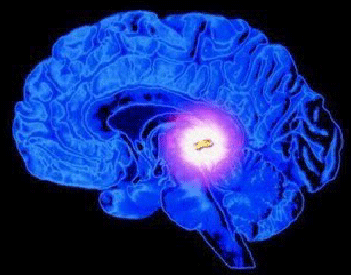
The pineal gland could possibly use its piezoelectric crystals to receive electromagnetic waves, converting the signals to electrical energy. It could also transmit this energy by some kind of resonance. Again, we just do not have enough serious research in this subject, but the existence of some type of interaction between an organism and a field is quite compelling.
The Field of God
Now we really leave solid ground -- and venture off to space.
Taken to its extreme, the existence of cellular fields, organism fields, species fields, etc. seem quite apparent. If we know these fields exist, perhaps there are even more fields which control larger populations of life. Some esoteric literature like The Keys of Enoch speak of a galactic field, capable of organizing and coordinating life and consciousness within the Milky Way [7]. They suggest that genetic evolution is intelligently manipulated by this field, and that the galactic field has been responsible for effecting beneficial and evolutionary changes to our DNA. In fact, the Keys describe what is been called a "system upgrade" that will soon be "downloaded" to humanity by means of this energy field, evolving us to another type of material and spiritual existence.
Some theorists have explained that it is only necessary for the galactic field to communicate one way (i.e. to transmit only) and that the pineal gland will receive the signal and adjust the organism to resonate with it. The idea is that the vibrations of the galactic field evolves life within its realm and does not need feedback from each organism or species that it influences. Others argue that every location in a field is local, so that the interaction between a small pineal gland and the galactic field is very plausible.

Along this line of inquiry, the Cognitive Sciences Laboratory in Palo Alto, California, has discovered a cycle during which ESP practitioners are "more" and "less" accurate in their abilities to "see" or predict events. When scientists examined the accuracy of thousands of ESP predictions, along with documented times these anomalous cognitions took place, the precognative cycle coincided with a specific Local Sidereal Time, or LST. This is the galactic time whereby the center of the Milky Way is used instead of the Sun.
The peak of efficiency was not, however, at galactic "high noon" when the center of our Galaxy is directly overhead. Peak efficiency was repeatedly at 13:30 LST. This would place the center of our Galaxy on the opposite side of the sky, essentially being obscured by the earth. It may or may not be significant but it suggests that some field, with its origins in the Milky Way, is influencing our minds and inhibits psychic abilities. The same has been found for solar radiation and electromagnetic disturbances from the Sun. Psychic abilities seem to be most efficient when these activities are at their minimum.
Perhaps the most interesting idea is to think of God as the originator of the universal field -- the ultimate technique whereby all energy and matter are controlled and maintained. The possibilities are truly amazing.
We started this story with the possum sitting in the tree. The adaptation of this animal shows that, although we really do not fully understand the methods at work, the Darwinian concept of random mutations and millions of years of natural selection is a paradigm whose days are numbered. The techniques of life and matter are now reaching their limits with mechanistic and non-spiritual impositions. Hopefully we will some day realize our role in this unfolding drama and have a better understanding of ourselves and our destiny. Then we will be at play in the field of God.
What are your thoughts?
Part 1 Notes[1] Tryon RC (1942). Individual differences. In F. A. Moss (Ed.), Comparative psychology (Rev. ed.). NY: Prentice-Hall.
[2] Tryon RC (1940). "Genetic differences in maze-learning ability in rats". Yearbook of the National Society for the Study of Education 39: 111-119.
[3] Cooper RM & Zubek JP (1958). "Effects of enriched and restricted early environments on the learning ability of bright and dull rats". Canadian Journal of Psychology 12 (3): 159-164. PMID 13573245.
[4] Principles of Neural Science, ER Kandel, JH Schwartz, TM Jessell, S Mack (1991) - (available on columbiauniversity.net)
[5] O'Connor, Anahad (2008-03-11). "The Claim: Identical Twins Have Identical DNA". New York Times. http://www.nytimes.com/2008/03/11/health/11real.html. Retrieved 2010-05-02.
[6] Fraga, M. F.; Ballestar, E; Paz, MF; Ropero, S; Setien, F; Ballestar, ML; Heine-Suner, D; Cigudosa, JC et al. (2005). "Epigenetic differences arise during the lifetime of monozygotic twins". Proceedings of the National Academy of Sciences 102 (30): 10604-9.
[7] O.J. Rando and K.J. Verstrepen (2007). "Timescales of Genetic and Epigenetic Inheritance". Cell 128 (4): 655-668. doi:10.1016/j.cell.2007.01.023. PMID 17320504.
[8] Lauren E. Heystek, Hui-qiang Zhou, Prasad Dande, and Barry Gold, "Control over the Localization of Positive Charge in DNA: The Effect on Duplex DNA and RNA Stability", J. Am. Chem. Soc., 1998, 120 (46), pp 12165-12166
Offspring inherit lots of characteristics from their parents' DNA. There are genes for size, hair color and brain development -- but was there somewhere in the possum's genes that stored the strategy of not looking at the hunter's flashlight?
This is not a new question. Survival behaviors of animals have been studied by many researchers, but their inherent programming has never been fully explained. How exactly is this strategy coded and passed on from one generation to the next? Can DNA do this?
The most famous study of survival strategies is outlined in Richard Dawkin's book, The Selfish Gene. Let's take look.
Evolutionay Stable Strategies (ESS)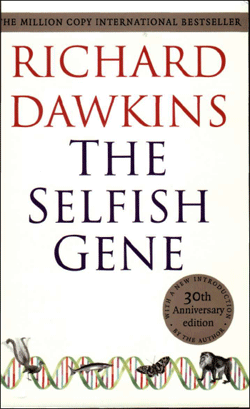 One of the most interesting ideas in The Selfish Gene originated from another researcher, Maynard Smith. He described what he termed Evolutionary Stable Stategies, or ESS. These are programmed behaviors which specific species use when they are threatened. These strategies are not taught or learned. They are carried out unconsciously by each organism in a particular species, suggesting that they are imparted to each generation at birth through genes. One of the most interesting ideas in The Selfish Gene originated from another researcher, Maynard Smith. He described what he termed Evolutionary Stable Stategies, or ESS. These are programmed behaviors which specific species use when they are threatened. These strategies are not taught or learned. They are carried out unconsciously by each organism in a particular species, suggesting that they are imparted to each generation at birth through genes.Smith listed five main strategies which are observed in the animal kingdom (including humans): The Hawk -- If threatened, attack and fight to the end. This strategy is to fight an opponent with the maximum effort, unrestrained and for as long as it takes to either win the battle or to quit because of death or injury. Dog and cock fights are examples of this kind of aggressive strategy. While one party will always win, the other party will suffer extreme losses, and possibly death. The Dove -- If threatened, threaten back but never fight. Run away if attacked. This strategy involves making threatening gestures but inflicting no real harm to the opponent. The threats are usually a kind of ritual or symbolic "gesture" which continues until one of the animals doing this gets tired, bored or simply gives up. No one is injured, one party wins, but often there is a loss of energy and time if each animal has equal stamina. 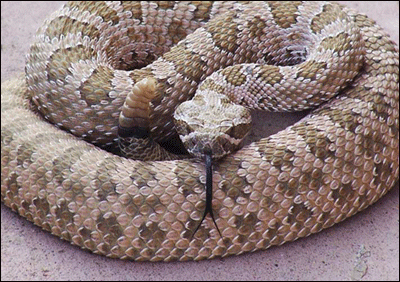 The Bully -- Act like a hawk when threatened (and hope the opponent is scared away). But if challenged, run away like a dove. This strategy works pretty well as the animal can "fake" that it is willing to fight to the death. And if it comes to a fight, it runs away to safety. The survival potential of the bully is pretty good, unless it encounters a real hawk. The Prober Retaliator -- Act like a retaliator with most encounters...but be unpredictable and sometimes switch to the hawk strategy -- even if the opponent is a dove! This is perhaps the most successful strategy for some animals because the outcome of an encounter with them is uncertain. Other animals will think twice before challenging them. Do any of these strategies sound familiar to you? They are exhibited in human competition, such as gaming (poker), government policies and even war games. The last one, Prober Retaliator, is the tactic used by many terrorist organizations. Not every strategy is the best for all animals. The strategy used by a particular species is determined by which outcome enables optimal survival and more replication of its own kind. It varies depending on the size and strength of the animals, the potential enemies it might encounter and the environment it lives in. Somehow, each species finds the precise strategy that maintains its numbers in a stable, viable population. When it is carefully analyzed, it is always the best choice for that particular species. While these strategies are interesting in themselves, the fact that they seem to be intelligently designed and unconsciously implemented by the species is even more so. But... designed by whom? And transmitted to each generation by what means? |
A maze of possibilities
 There is some evidence that strategic behavior can be transmitted by genes. A classic example is Tryon's experiment on the maze-running ability in rats [1][2]. Tryon managed to breed two groups of rats by selectively mating the "best" maze runners with each other and, conversely, the "worst" maze runners. After seven generations he could show that he had produced two distinct heredity groups with a vast innate differences in their maze running abilities. This was believed by many to be proof that behavior was inherited, and therefore a product of DNA. But his results were soon challenged.
There is some evidence that strategic behavior can be transmitted by genes. A classic example is Tryon's experiment on the maze-running ability in rats [1][2]. Tryon managed to breed two groups of rats by selectively mating the "best" maze runners with each other and, conversely, the "worst" maze runners. After seven generations he could show that he had produced two distinct heredity groups with a vast innate differences in their maze running abilities. This was believed by many to be proof that behavior was inherited, and therefore a product of DNA. But his results were soon challenged.When the "worst" maze runners were subjected to an enriched environment with more objects to explore and more social interactions to enjoy, their maze running abilities were restored. What's more interesting is that their offspring continued to have improved maze running abilities -- even without the stimulating activities [3]. In just one generation this "inherited" deficit was earased. This result suggested that the maze running ability was the product of an interaction of genes and environment, where the genetic effect is only seen under some environmental conditions. If that is true, how can genes change so quickly -- even in the sameorganism?
Small changes have big results
Scientists continued to examine how small genetic changes could alter complex behavior. Their first success was in explaining how an animal could be programmed to be more "hawkish" or "dovish". As reported in Principles of Neural Science (1992):
"Most animals, including humans, become aggressive when threatened, such as when their territory is invaded, their offspring are attacked, or sexual interactions are prevented. The importance of serotonergic transmission in aggressive behavior is clearly evident in studies of mice in which the gene for the serotonin 1B receptor has been ablated by targeted deletion.
When mice lacking serotonin 1B receptor are isolated for four weeks and then exposed to a wild-type mouse, they are much more aggressive than wild-type animals under similar conditions. The mutant mice attack intruders faster than wild-type mice or mice lacking only one copy of serotonin 1B receptor gene, and the number and intensity of attacks is significantly greater than that of the wild-type mice. Thus, the serotonin 1B receptor plays a role in mediating aggressive behavior in mice... [4]While the mechanism for generalized behavior strategies (like being more or less aggressive) seemed to implicate genes and their ability to alter certain neurotransmitters, it was still not known how genes could also modify specific behaviors -- like making the possum turn its eyes from the hunter's flashlight.
Some amazing examples of genetically encoded, complex behaviors have been studied in monozygotic twins -- siblings with the exact copies of their DNA -- who were separated at birth and reared in different environments.
| Identical Twins Reared Apart
Human monozygotic (MZ) twins account for 1 in 250 live births. The origin of MZ twins is attributed to two or more daughter cells of a single zygote (fertilized egg) undergoing independent cell divisions, leading to independent development and births.
Although they are considered genetically identical at birth, significant differences between MZ twins may exist, becoming more evident with age. But the main focus of study has been on the remarkable similarities which involve complex behaviors, personality and interests. These are, after all, strategies that humans use to survive conflicts. The Minnesota Twins, as they are known, are perhaps the most reported case involving two male babies who were monozygotic twins, separated at when they were only 4 months old, and each adopted by a different family.  At age five, Lewis learned that he had a twin, but he said that the notion never truly "soaked in" until he was 38 years old. Springer learned of his twin sibling at age eight, but both he and his adoptive parents believed the sibling had died. The two were finally reunited at age 39. The similarities the twins shared not only amazed one another, but researchers at the University of Minnesota as well. The very fact that you had twin siblings separated at birth bearing the same name, both 6 feet tall and weighing exactly 180 pounds is pretty incredible. But there's more. Consider these coincidences:
Daphne and Barbara are also examples of subtle behaviors that are apparently transmitted through genes.  Daphne Goodship and Barbara Herbert first met when they were 40. Debbie was raised Jewish and Sharon was raised Catholic. Daphne Goodship and Barbara Herbert first met when they were 40. Debbie was raised Jewish and Sharon was raised Catholic.According to Barbara, "We discovered we had a miscarriage the same year, followed by two boys and a girl in that order." They joke that they've also cooked the same meal from the same recipe book on the same day, without knowing it. Daphne and Barbara have been called the "giggle twins" because they laugh and fold their arms the same way.  Identical twins Tom Patterson and Steve Tazumi met four years ago. Tom is from rural Kansas, he was raised Christian and his parents were janitors. Steve, raised as a Buddhist, lives in Philadelphia. His father was a pharmacist. Identical twins Tom Patterson and Steve Tazumi met four years ago. Tom is from rural Kansas, he was raised Christian and his parents were janitors. Steve, raised as a Buddhist, lives in Philadelphia. His father was a pharmacist.However, Tom and Steve chose the same careers. "It's phenomenal," says Steve. "He owned a body building gym and I owned a body building gym. We're both 100 percent into fitness." But there are differences in these twins, too. Steve says he's more party oriented while Tom is more family oriented. Heredity vs Environment Although there is ample documentation for these similar personality traits in identical twins, it is not without some controversy. In her book Identical Twins Reared Apart: A Reanalysis, Susan Farber noted that many of the cases studied were based on subjects who were recruited by asking television viewers to refer people who were identical twins. She claimed that these twins would have been the most obvious to look and act similar. In other words, the selection was not unbiased. She attempted to set the record straight and based her own research on a study that selected twin births from the Danish registry, between 1954 and 1959, and found 12 identical twins that were reared apart. Farber summarized her review by stating that identical twins who shared the same home life were almost 80% similar, while those reared apart were only 60% alike. Although this certainly proves that environment has a role in shaping behavior, it still makes a strong case for genetics. In the examples above, interests, professions, and even the way we laugh seems to be encoded in our genes. Yet, the environment can modulate this genetic expression. How is that achieved? |
Epigenetics: the new frontier
If the genes can be likened to long list of instructions, we have learned that some of these instructions can be marked "to do" (activated) or "ignore" (inhibited). Scientists have recently come to understand that, although the list itself remains intact, the various instructions undergo activation and inhibition in a process called epigenetics.
This process is vital when a single fertilized egg (zygote) divides and the cells differentiate to become muscle, tissue, nerve cells skeletal cells, etc. Each different type of cell requires a different set of proteins and different sets of instructions are activated or inhibited. These sets of instructions stabilize and continue over the life of the cell and over many generations as the cell divides and reproduces.
Epigenetics is the result of turning a set of DNA instructions on (activated) or off (inhibited). The process is well understood for the methylation process, where a molecule containing one atom of carbon and three atoms of hydrogen (CH3) attaches to specific genes to turn them off (inhibit) and prevent their instructions from being used to make specific proteins. The histone modification of genes is less understood but involves a molecule that attaches to part of the gene, causing it to deform and interfering with its ability to make a specific protein -- essentially turning it off. The attachment of these switching molecules is achieved through the control of ion charges at the specific site. The charges then facilitate the molecular bond and inhibit the gene from replicating and producing its specific protein [8]. The production of specific proteins is critical to life and even minor changes at the genetic level can have dramatic consequences. Much of our genetic code is not completely understood and so-called "junk DNA" may contain instructions that have very specific roles to play in our behavior and thinking. In our earlier example of the possum, it is possible that some kind of epigenetic change causes increased light sensitivity, making the possum turn its head to avoid the glare of the hunter's flashlight. This subtle change in gene expression becomes a survival strategy and is passed on to offspring. |
Scientists were surprised to discovered that epigenetics was an on-going process, not limited to differentiating cell types. In fact, they found that environmental factors, such as toxins, temperature or the availability or scarcity of food, could cause epigenetic changes that modified the behavior and form of the organism. These adaptations happened quickly and within the lifespan of the same organism. In some cases, the changes to "activate" or "inhibit" certain instructions were passed to subsequent generations implying that our Darwinian concept of multi-generation evolution needs amending. Evolutionary adaptation can occur in a single generation!
Back to the twins...
 It was always assumed that our DNA was an unchanging set of instructions. And because of this, MZ twins were assumed to have been born with identical sets of genes. But scientists were curious about some cases where one twin would develop certain types of diseases and the other did not. When they examined the DNA of older twins they were shocked -- their DNA was different! [5]
It was always assumed that our DNA was an unchanging set of instructions. And because of this, MZ twins were assumed to have been born with identical sets of genes. But scientists were curious about some cases where one twin would develop certain types of diseases and the other did not. When they examined the DNA of older twins they were shocked -- their DNA was different! [5]A study published in The American Journal of Human Genetics, conducted by scientists at the University of Alabama at Birmingham and universities in Sweden and the Netherlands examined the genes of 10 pairs of MZ identical twins, including 9 pairs in which one twin showed signs of dementia or Parkinson's disease and the other did not. According to Professor Jan Dumanski:
"These epigenetic changes -- which accumulate over a lifetime and can arise from things like diet and tobacco smoke -- have been implicated in the development of cancer and behavioral traits like fearfulness and confidence, among other things. Epigenetic markers vary widely from one person to another, but identical twins were still considered genetically identical because epigenetics influence only the expression of a gene and not the underlying sequence of the gene itself...
When we started this study, people were expecting that only epigenetics would differ greatly between twins. But what we found are changes on the genetic level, the DNA sequence itself." [5]The study showed that the longer DNA is exposed to environmental influences, the more likely it is to develop epigentic adaptations. It also suggests that these epigenetic changes can stabilize and be passed to subsequent generations upon birth [6]. But the remarkable thing is that these epigenetic changes can also manifest in the actual genetic code of the DNA -- making the changes permanent -- and do this within the lifespan of a single organism! [7] The mechanism for this appears to be something called cytosine deaminase which can change both epigenetic code and the base DNA code.
So it appears that nature has equipped the organism with a two tiered approach to adaptation. First, temporary changes in gene expression can be implemented through epigentics. These will take effect quickly and can be passed to subsequent generations to help the organism adapt, but they are NOT permanent. However, if these changes persist and prove successful in the adaptation of the organism, permanent genetic mutations will follow and constitute a form of natural selection.
Who designs these adaptive changes?
We ask the question with "who" because we recognize that the specific genes involved in the adaptation of the organism appear to be selected intelligently. Intelligence usually signifies sentience and consciousness. But perhaps we err in our inquiry.
The intelligence of natural selection is not in each specific choice of adaptation. Rather it is in the grand design of the natural selection process which appears to involve something as yet illusive to mechanistic science.
How does the possum adapt to the hunter's flashlight? Initially it may be a random case of over-sensitivity to the light resulting from some anomaly in protein synthesis. Because this anomaly proves to be a successful strategy for survival, its epigenetic code endures until it has reached a certain saturation in the population of possums. At this point, presumably, some mechanism is able to make the gene expression permanent.
But there is also the possibility that the sensitivity to light was not a random anomaly.
In the next installment of this series, we will examine a theory which explains how the organism's cells "know" when a particular epigenetic change has been an effective survival strategy. We will explore the so-called mitogenetic and morphogenetic fields, how an organism communicates with the field and how epigenetic changes can spread throughout a species -- even when there is no physical contact or reproductive lineage.
We'll be treading on hollowed ground as we explore the possibility that fields of energy permeate the universe, unifying and coordinating everything.
Part 2
Less is more, more is less...
The general public was made aware of the discovery of epigenetics through an article in Time Magazinein 2010.
 The feature article began with the story of an European farming village that endured several years of crop failure and famine. But there were also a couple of extremely plentiful years, during which the inhabitants over-ate and became gluttonous. During the glutton years, some of the children were entering puberty and subsequently got married and had families.
The feature article began with the story of an European farming village that endured several years of crop failure and famine. But there were also a couple of extremely plentiful years, during which the inhabitants over-ate and became gluttonous. During the glutton years, some of the children were entering puberty and subsequently got married and had families.When researchers first looked at this population, they were expecting to find birth defects and inherited deficits from the near starvation conditions that persisted for years. Instead, they discovered that the offspring of the pubescent gluttons had an amazing decrease in lifespan of more than 32 years!
"Once Bygren and his team controlled for certain socioeconomic variations, the difference in longevity jumped to an astonishing 32 years. Later papers using different Norrbotten cohorts also found significant drops in life span and discovered that they applied along the female line as well, meaning that the daughters and granddaughters of girls who had gone from normal to gluttonous diets also lived shorter lives." [1]Animal studies have long confirmed the relationship between eating less and longevity (see viewzone article), and it is accepted that over-eating and obesity can shorten an organism's life through diseases such as diabetes and heart attacks. But these outcomes usually are apparent only to the offending organism -- not to their offspring.
The Time Magazine article used this research to illustrate how epigenetics, caused by environmental factors, can have hereditary consequences that ripple through many generations. But there were two important questions that were not addressed: first, why would epigenetics punish the offspring for their ancestor's over-eating by shortening their lifespan? Second, how is it that the offspring of both males and females were effected?
In mammals, the male produces sperm as needed during puberty and so the DNA is subject to environmental effects and presumably epigenetic adaptations. Research has shown, for example, that boys who smoked cigarettes at age 11 had male offspring that were more unhealthy and obese than children of non-smoking fathers. The toxins in cigarette smoke are suspected of altering the genes (Y chromosome) in their sperm [2]. Females, on the other hand, are born with a lifetime supply of eggs that are stored in their ovaries. These unfertilized eggs are complete. Their DNA is already established. Are their eggs still subject to epigenesis?
Let's examine these two questions more carefully.
| The Wrath of Epigenetics...
Remember the Evolutionary Stable Strategies (ESS) we discussed in Part 1 of this article? The strategies that organisms use for survival all follow a basic law.
 The words, "The needs of the many outweigh the needs of the few (or the one)", are found in the motion picture Star Trek: The Wrath of Khan, and were spoken by the character Mr. Spock, and attributed to the Vulcan philosopher Surak. They describe (even better than Dowkins) the operational motive at work in the strategies implemented by epigenetics. The words, "The needs of the many outweigh the needs of the few (or the one)", are found in the motion picture Star Trek: The Wrath of Khan, and were spoken by the character Mr. Spock, and attributed to the Vulcan philosopher Surak. They describe (even better than Dowkins) the operational motive at work in the strategies implemented by epigenetics.Here's how Dowkins described the same thing: "By some unspecified mechanism, the animal behaves as if he were following these instructions.An evolutionarily stable strategy or ESS is defined as a strategy which, if most members of a population adopt it, cannot be bettered by an alternative strategy. It is a subtle and important idea. Another way of putting it is to say that the best strategy for an individual depends on what the majority of the population are doing. Since the rest of the population consists of individuals, each one trying to maximize his own success, the only strategy that persists will be one which, once evolved, cannot be bettered by any deviant individual. Following a major environmental change there may be a brief period of evolutionary instability, perhaps even oscillation in the population. But once an ESS is achieved it will stay: selection will penalize deviation from it . [3]In the case of the gluttonous ancestors, their action signalled a danger to the group. Sensing that food was normally scarce, an over-eater would have threatened the survival of offspring if they were allowed to exist beyond their reproductive and child-rearing years. Since the normal life span is well past 60, cutting their lives by 32 years provides assurance that they will replicate. After that they are, to the group, "useless over-eaters." In the case of the pre-teen smokers, the wisdom of epigenetics is also at work, culling the offspring of those individuals who engage in damaging habits that threaten to spread unhealthy activities within the group. Remember, second-hand smoke is also toxic. I hope, like me, that you are beginning to see some type of overcontrol and active intervention at work here. These genetic changes are very real and adhere to their mission with intelligence. But we'll have more to say about that later. The Kindness of Epigenetics... Not all effects of epigenetics are bad. When a strategy benefits the group, as within a species, genetic changes can be positive. Consider the work of Harvard psychologist William McDougall who spent 15 years training rats how to escape from a tank. His first group of rodents made an average of 200 mistakes before learning the correct way out and being rewarded with food. With successive breeding, McDougall arrived at a generation that could complete the task with only 20 mistakes. He repeated the same experiment many times and felt that he demonstrated that learning could be passed along in genes. [4] On the other side of the planet, in Australia, researchers were anxious to replicate McDougall's work and so secured a population of the same species of rats to begin the breeding experiment. To their surprise, the rats could immediately find their way out of the tank in just 20 trials! Further tests demonstrated that this was the new baseline for rats as a species. There are many such reports, including the case of the 100 monkeys that we described in a recent viewzone article. In each case, positive survival adaptation (i.e. securing food) is transmitted to members of the group or species even if there is no direct genetic inheritance. Yet, because subsequent generations exhibit the new behavior, it seems probable that it is the result of some genetic change which mechanistic theorists are at a loss to explain. Sex is not a factor... Although we should expect that male sperm can be affected by the environment, the fact that offspring of gluttonous females had a severely reduced life span is remarkable. It suggets that epigenetic changes can exist within the eggs of a woman's ovaries. Taken together with the fact that the older MZ twins showed changes in DNA code throughout their entire body, this suggests that epigenetics is not a mere accident, mistake or anomaly that happens to a local group of cells. It is systemic. All DNA is changed! So what could be going on here? We will next examine a theory that expands on the morphogenetic field as a kind of "intelligence" which coordinates the response of a group of organisms to environmental challenges. Because this theory deals with a "field" (action at a distance) it has little empirical support. But keep an open mind and see if it makes sense. |
The Morphogenetic Field (again)
On average, every human being consists of approximately 10 trillion cells. Inside each cell there are chemical reactions happening at the rate of more than 100,000 every second! [5] In every second approximately 10 million cells die. These dead cells must be replaced in a short period of time in order to prevent entropic decay. It cannot be predicted where and when a cell will die, but if the replacement rate is only slightly lower (or higher), the body will disintegrate quickly. A good example of this are the cells that line the intestines, which have an unusually large turnover rate. If the replacement rate should exceed the cell death rate by only a small percent, the body would rapidly die from an obstruction.
Mechanisms such as bio-molecular control or chemical "messengers" are clearly not efficient enough to coordinate this life process. This activity requires a level of organization, coordination and overcontrol that must happen at the speed of light. Viewzone covered this topic extensively in our feature Does DNA Emit Light?.
Rupert Sheldrake, with a PhD in biochemistry from Cambridge, is a fellow of the Institute for Noetic Sciences, founded by former astronaut Edgar Mitchell. In his 1981 book A New Science of Life: Hypothesis of Formative Causation he coined the term "morphogenetic field" for coordinating fields that govern the development and cooperation of living organisms. Sheldrake believed that DNA might actually function like a resonance coil (the double helix even looks a bit like radio coil) and receive instructions from the field.
While this might explain the intra-cellular communication, it does not explain how an organism -- made of trillions of individual cells -- can send and receive information and use this information to create genetic alterations and adaptations. To make this theory plausible, we need to find some organ capable of communicating with every cell in the body, having some type of ion capability (since the methyl and histone molecular "switches" attach and inhibit the genes because of altered ion charges on the DNA)[8] and having the ability to interact with the electromagnetic spectrum to communicate with the so-called morphogenetic field.
The Pineal Gland
The pineal gland is a pea size structure in the brain that, amazingly, meets all of the above requirements needed to interact with the morphogenetic field and effect changes to the genes on a systemic basis.

- It has the richest blood supply of the body, second only to the kidneys [*]. The blood is the only method whereby every cell in the body can be reached -- even those in the ovaries. The pineal gland already functions in this manner as the "master regulator" of day-night rhythms as well as the most significant producer of neurotransmitters like serotonin and melotonin.
- The pineal gland contains calcite piezoelectric crystals which accumulate with age.
"Length dimensions of the crystals varied from 2-3 to about 20 micrometres. These results (referring to various forms of analysis described in detail) and the electron diffraction measurements definitely prove that the microcrystals are calcite. These calcite crystals bear a striking resemblance to the otoconia of the inner ear. The calcite in otoconia has been shown to exhibit piezoelectricity. If piezoelectricity were to exist [in the pineal calcite microcrystals], an electromechanical coupling mechanism to external electromagnetic fields may be possible." [6]
 One of the earliest types of radio was the "crystal set" [right], in which a mineral crystal was made to resonate (by tuning with a "cats whisker") with an incoming radio wave, which is simply an electromagnetic wave, propogating at the speed of light.
One of the earliest types of radio was the "crystal set" [right], in which a mineral crystal was made to resonate (by tuning with a "cats whisker") with an incoming radio wave, which is simply an electromagnetic wave, propogating at the speed of light.
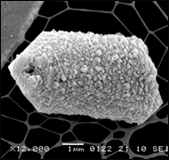
The pineal gland could possibly use its piezoelectric crystals to receive electromagnetic waves, converting the signals to electrical energy. It could also transmit this energy by some kind of resonance. Again, we just do not have enough serious research in this subject, but the existence of some type of interaction between an organism and a field is quite compelling.
The Field of God
Now we really leave solid ground -- and venture off to space.
Taken to its extreme, the existence of cellular fields, organism fields, species fields, etc. seem quite apparent. If we know these fields exist, perhaps there are even more fields which control larger populations of life. Some esoteric literature like The Keys of Enoch speak of a galactic field, capable of organizing and coordinating life and consciousness within the Milky Way [7]. They suggest that genetic evolution is intelligently manipulated by this field, and that the galactic field has been responsible for effecting beneficial and evolutionary changes to our DNA. In fact, the Keys describe what is been called a "system upgrade" that will soon be "downloaded" to humanity by means of this energy field, evolving us to another type of material and spiritual existence.
Some theorists have explained that it is only necessary for the galactic field to communicate one way (i.e. to transmit only) and that the pineal gland will receive the signal and adjust the organism to resonate with it. The idea is that the vibrations of the galactic field evolves life within its realm and does not need feedback from each organism or species that it influences. Others argue that every location in a field is local, so that the interaction between a small pineal gland and the galactic field is very plausible.

The peak of efficiency was not, however, at galactic "high noon" when the center of our Galaxy is directly overhead. Peak efficiency was repeatedly at 13:30 LST. This would place the center of our Galaxy on the opposite side of the sky, essentially being obscured by the earth. It may or may not be significant but it suggests that some field, with its origins in the Milky Way, is influencing our minds and inhibits psychic abilities. The same has been found for solar radiation and electromagnetic disturbances from the Sun. Psychic abilities seem to be most efficient when these activities are at their minimum.
Perhaps the most interesting idea is to think of God as the originator of the universal field -- the ultimate technique whereby all energy and matter are controlled and maintained. The possibilities are truly amazing.
We started this story with the possum sitting in the tree. The adaptation of this animal shows that, although we really do not fully understand the methods at work, the Darwinian concept of random mutations and millions of years of natural selection is a paradigm whose days are numbered. The techniques of life and matter are now reaching their limits with mechanistic and non-spiritual impositions. Hopefully we will some day realize our role in this unfolding drama and have a better understanding of ourselves and our destiny. Then we will be at play in the field of God.
What are your thoughts?
Part 1 Notes[1] Tryon RC (1942). Individual differences. In F. A. Moss (Ed.), Comparative psychology (Rev. ed.). NY: Prentice-Hall.
[2] Tryon RC (1940). "Genetic differences in maze-learning ability in rats". Yearbook of the National Society for the Study of Education 39: 111-119.
[3] Cooper RM & Zubek JP (1958). "Effects of enriched and restricted early environments on the learning ability of bright and dull rats". Canadian Journal of Psychology 12 (3): 159-164. PMID 13573245.
[4] Principles of Neural Science, ER Kandel, JH Schwartz, TM Jessell, S Mack (1991) - (available on columbiauniversity.net)
[5] O'Connor, Anahad (2008-03-11). "The Claim: Identical Twins Have Identical DNA". New York Times. http://www.nytimes.com/2008/03/11/health/11real.html. Retrieved 2010-05-02.
[6] Fraga, M. F.; Ballestar, E; Paz, MF; Ropero, S; Setien, F; Ballestar, ML; Heine-Suner, D; Cigudosa, JC et al. (2005). "Epigenetic differences arise during the lifetime of monozygotic twins". Proceedings of the National Academy of Sciences 102 (30): 10604-9.
[7] O.J. Rando and K.J. Verstrepen (2007). "Timescales of Genetic and Epigenetic Inheritance". Cell 128 (4): 655-668. doi:10.1016/j.cell.2007.01.023. PMID 17320504.
[8] Lauren E. Heystek, Hui-qiang Zhou, Prasad Dande, and Barry Gold, "Control over the Localization of Positive Charge in DNA: The Effect on Duplex DNA and RNA Stability", J. Am. Chem. Soc., 1998, 120 (46), pp 12165-12166
Part 2 Notes
[1] Time Magazine
[2] European Journal of Human Genetics (2006)
[3] The Selfish Gene, Dowkins, p92
[4] McDougall (1938), Forth report on a Lamarckian experiment, Brit. J. Psychol. 28, 321-345
[5] The Real Bioinformatics Revolution: Proteins and Nucleic Acids Singing to One Another? (Paper available at report@i-sis.org.uk)
[6] Bioelectromagnetics 23:488495 (2002) "Calcite Microcrystals in the Pineal Gland of the Human Brain -- First Physical and Chemical Studies", Baconnier, Lang et al.
[7] Keys of Enoch, JJ.Hurtal, Key 3-1-3, p469.
[8] Lauren E. Heystek, Hui-qiang Zhou, Prasad Dande, and Barry Gold, "Control over the Localization of Positive Charge in DNA: The Effect on Duplex DNA and RNA Stability", J. Am. Chem. Soc., 1998, 120 (46), pp 12165-12166



 Charles Manson & Jeffrey Dahmer, mass murderers with apparently no conscience.
Charles Manson & Jeffrey Dahmer, mass murderers with apparently no conscience.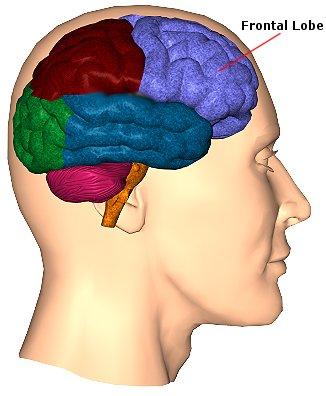 The causes of this sociopathic disorder have been narrowed to several factors through research. One of the primary causes of sociopathic behavior is believed to be neurological abnormalities mainly in the frontal lobe [ picture left] of the brain.
The causes of this sociopathic disorder have been narrowed to several factors through research. One of the primary causes of sociopathic behavior is believed to be neurological abnormalities mainly in the frontal lobe [ picture left] of the brain.
 Most extreme sociopaths end up, at some time, in the prison system.
Most extreme sociopaths end up, at some time, in the prison system. In the case of the Virginia Tech shooter, Cho Seung, we see how clearly the medical and mental health system failed to handle this blatant example of sociopathic behavior. Described as a "loner" with a violent obsession, Cho had all the characteristics of an individual who was in his own world, surrounded by his own unmet desires and goals and frustrated by his lack of social skills. His anger at father figures, authority and successful people further caused him to withdraw inward. In the end, his lack of emotion allowed him to commit the mass murders and to do the ultimate act of denial -- his own self-preservation.
In the case of the Virginia Tech shooter, Cho Seung, we see how clearly the medical and mental health system failed to handle this blatant example of sociopathic behavior. Described as a "loner" with a violent obsession, Cho had all the characteristics of an individual who was in his own world, surrounded by his own unmet desires and goals and frustrated by his lack of social skills. His anger at father figures, authority and successful people further caused him to withdraw inward. In the end, his lack of emotion allowed him to commit the mass murders and to do the ultimate act of denial -- his own self-preservation. Parenting class should be mandatory curriculum in our schools.
Parenting class should be mandatory curriculum in our schools.
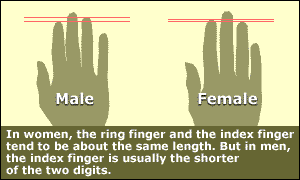 In a study to be published in the British Journal of Psychology, scientists compared the finger lengths of 75 children with their Standardised Assessment Test (
In a study to be published in the British Journal of Psychology, scientists compared the finger lengths of 75 children with their Standardised Assessment Test (
 Oimitrios Tricopouos, an epidemiologist at Harvard University, proposed a decade ago that breast cancer may originate in the uterus of the mother (The Lancet, vol. 335, p 939). He suggested that high concentrations of estrogen may create a "fertile soil" for cancer to develop later in life. He also thought that variability in estrogen levels during pregnancy may help to explain why breast cancer rates are generally higher in women born to Caucasian mothers compared with those born to Oriental or younger mothers. Recently he and his colleague Karin Michels showed that high birth weight in girls-another sign of high prenatal estrogen levels-was associated with an increased risk of breast cancer.
Oimitrios Tricopouos, an epidemiologist at Harvard University, proposed a decade ago that breast cancer may originate in the uterus of the mother (The Lancet, vol. 335, p 939). He suggested that high concentrations of estrogen may create a "fertile soil" for cancer to develop later in life. He also thought that variability in estrogen levels during pregnancy may help to explain why breast cancer rates are generally higher in women born to Caucasian mothers compared with those born to Oriental or younger mothers. Recently he and his colleague Karin Michels showed that high birth weight in girls-another sign of high prenatal estrogen levels-was associated with an increased risk of breast cancer.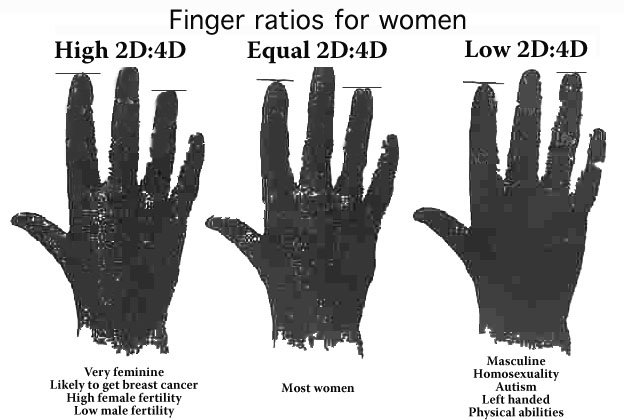
 Manning has begun examining autism too. He teamed up with Simon Baron- Cohen and Svetlana Lutchmaya from the University of Cambridge, who have used samples of amniotic fluid to directly measure the levels of hormones that babies are exposed to in the womb. When the children reached their first birthday, the researchers measured their vocabularies and ability to make eye contact. Poor language skills and an unwillingness to make eye contact are early hallmarks of autism. They found that babies who'd been exposed to high levels of testosterone in the womb fared the worst.
Manning has begun examining autism too. He teamed up with Simon Baron- Cohen and Svetlana Lutchmaya from the University of Cambridge, who have used samples of amniotic fluid to directly measure the levels of hormones that babies are exposed to in the womb. When the children reached their first birthday, the researchers measured their vocabularies and ability to make eye contact. Poor language skills and an unwillingness to make eye contact are early hallmarks of autism. They found that babies who'd been exposed to high levels of testosterone in the womb fared the worst. Manning recruited 54 male musicians from a British symphony orchestra. He discovered that these men had significantly lower 2D:4D ratios than controls -- they had a very "masculine" ratio. Even more striking, when he compared the top-ranked "first" musicians with their lower-ranked colleagues -- a measure of their relative ability-the former had significantly lower 2D:4D ratios. Could testosterone really predispose the brain to be more tuned in to music? Manning thinks so.
Manning recruited 54 male musicians from a British symphony orchestra. He discovered that these men had significantly lower 2D:4D ratios than controls -- they had a very "masculine" ratio. Even more striking, when he compared the top-ranked "first" musicians with their lower-ranked colleagues -- a measure of their relative ability-the former had significantly lower 2D:4D ratios. Could testosterone really predispose the brain to be more tuned in to music? Manning thinks so.



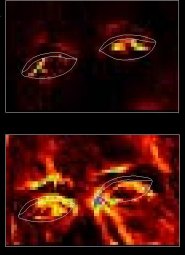


 The Eleusinian Mysteries endured for 2000 years because they provided their initiates with a glimpse of the afterlife which sustained them psychologically and spiritually, dramatically changing their lives. What we have learned about this initiation has been leaked by famous personalities in history who dared to write about it.
The Eleusinian Mysteries endured for 2000 years because they provided their initiates with a glimpse of the afterlife which sustained them psychologically and spiritually, dramatically changing their lives. What we have learned about this initiation has been leaked by famous personalities in history who dared to write about it. The phosphene method was used by Michel de Nostredame, Nostradamus, in the 1500s, to see the future. It is obvious that he did not invent this method himself but it shows that staring at a bright source of light was a legitimate way to connect with the "other side."
The phosphene method was used by Michel de Nostredame, Nostradamus, in the 1500s, to see the future. It is obvious that he did not invent this method himself but it shows that staring at a bright source of light was a legitimate way to connect with the "other side."
 Followers of Zoroaster worship fire, but not as a deity. They see fire as representing the energy of the Creator and as the messenger of truth. Devotees face the sacred flame in their ceremonies and practice the phosphene technique, mixing the light and after-image with "good thoughts". They also utilize water, which reflects the Sun and Moon. The Fire Temple of Yazd (Iran) [above] has a large pool of water for this kind of contemplation. In Mumbai (India) [right], Zoroastrian devotees worship while basking in the reflections of the sea, mixing meditation with the phosphene procedure.
Followers of Zoroaster worship fire, but not as a deity. They see fire as representing the energy of the Creator and as the messenger of truth. Devotees face the sacred flame in their ceremonies and practice the phosphene technique, mixing the light and after-image with "good thoughts". They also utilize water, which reflects the Sun and Moon. The Fire Temple of Yazd (Iran) [above] has a large pool of water for this kind of contemplation. In Mumbai (India) [right], Zoroastrian devotees worship while basking in the reflections of the sea, mixing meditation with the phosphene procedure.
 Modern psychologists have found that wall-gazing is a great way to induce alpha in both its upper and lower (and even upper theta) frequency ranges. It was the first hint at what was likely going on in the mind of the initiates and what these phosphenes were actually doing.
Modern psychologists have found that wall-gazing is a great way to induce alpha in both its upper and lower (and even upper theta) frequency ranges. It was the first hint at what was likely going on in the mind of the initiates and what these phosphenes were actually doing.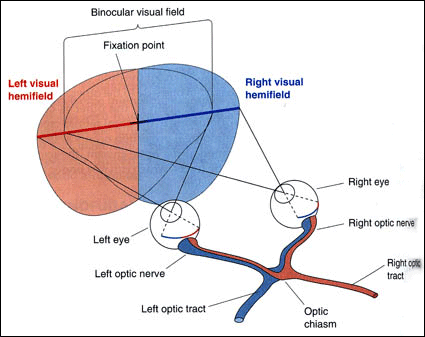
 First, don't look at the Sun for more than a few seconds. In fact, it is better to use an ordinary light bulb in a dark room. The results will be the same. In my research I have read that a 60-watt incandescent bulb placed two meters (about 5 feet) away is sufficient to produce the effect. Then, of course, there is always the white wall... (But the wall must take up the entire field of vision to avoid distractions of form, shape or color.)
First, don't look at the Sun for more than a few seconds. In fact, it is better to use an ordinary light bulb in a dark room. The results will be the same. In my research I have read that a 60-watt incandescent bulb placed two meters (about 5 feet) away is sufficient to produce the effect. Then, of course, there is always the white wall... (But the wall must take up the entire field of vision to avoid distractions of form, shape or color.)